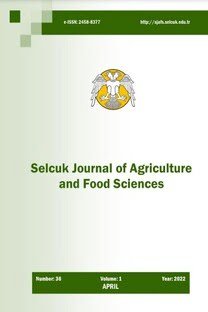Harran Ovası'nda pamukta zarar yapan pembekurt (Pectinophora gossypiella saund.) ve dikenlikurt (Earias insulana boisd.)' un ergin populasyon gelişimi
Harran Ovası 'nda Pembekurt (Pectinophora gossypiella Saund.) ve Dikenlikurt (Earias insulana Boisd.) 'un populasyon gelişimini tespit etmek için bu çalışma, 2002-2003 yıllarında yürütülmüştür. Zararlılardan Dikenlikurt 'un populasyon değişimlerini saptamak için ışık uzakları, Pembekurt 'un populasyon değişimini saptamak için de feromon tuzakları kullanılmıştır. Dikenlikurt'un ışık tuzaklarında saptanan populasyon gelişmesinde, her iki yılda da biri eylül ayında diğeri ise ekim ayında olmak üzere iki tepe noktası oluşturmuştur. Pembekurt'un feromon tuzaklarında saptanan populasyon gelişmesinde, 2002 yılında ağustos ve eylül aylarında iki, 2003 yılında ise, ağustos ve eylül aylarında üç tepe noktası oluşturmuştur. Her iki zararlı, Harran Ovası 'nda yetiştirilen pamuklardaki zararına devam ettiği, Dikenlikurt 'un populasyonunda azalma görülse de bazı yerlerde lokal olarak zarar oluşturabildiği, Pembekurt 'un ise pamuk alanlarını tehdit eder bir zararlı olduğu belirlenmiştir.
Anahtar Kelimeler:
Pectinophora gossypiella, Earias insulana, pamuk, bitki zararlıları, populasyon gelişimi, fauna, Harran Ovası
The development of moth population of pink bollworm (Pectinophora gossypiella saund.) and spuny bollworm
In this study, to determine of the development of moth population of Pink Bollworm (Pectinophora gossypiella Saund.,) and Spiny Bollworm (Earias insulana Boisd.,) were conducted in 2002-2003. Light traps and pheromone traps were used SBWand PBW, respectively. In the population development ofSBW; two peaks, one of them occurs in September, the other occurs in October, were established through light traps in both years. The development of population of PBW in pheromone traps had resulted in two peaks in the months of August and September in 2002, however the number of peaks in August and September in 2003 was three. As a result, both pests continued to cause infestation on cotton which grown in Harran Plain. SBW has less population than the preceding years as in a local area and PBW is a continuous threat in cotton grown area.
Keywords:
Pectinophora gossypiella, Earias insulana, cotton, plant pests, population growth, fauna, Harran Plain,
___
- Abou-El Hagag, G.H., 1998. Seasonal abundance of certain cotton pest and their associated natural enemies in Southern Egypt. Assuit Journal of Agricultural Sciences. 29(3): 253-267.
- Anonymous, 2004a. http://www.gap.gov.tr/Turkish/
- Anonymous, 2004b. Şanlıurfa Tarım İl Müdürlüğü, Proje ve İstatistik Şubesi Kayıtları.
- Göven, M. A., 1995. Güneydoğu Anadolu Bölgesi pamuk ekim alanlarındaki zararlılar ile ilgili sorunlar ve çözüm önerileri. GAP Bölgesi Bitki Koruma Sorunları ve Çözüm Önerileri Sempozyumu, 27-29 Nisan 1995, Şanlıurfa, 282-289.
- Özpınar, A., Ünlü, L. ve Yıldız, Ş., 1998. Şanlıurfa İlinde Pamuk Zararlısı Dikenlikurt (Earias insulana Boisd.)’un Bulaşma Oranı ve Populasyon Gelişmesinin Belirlenmesi. HR.Ü. Zir. Fak. Dergisi 2(4): 1-10
- Qureshi, Z.A. and Ahmed, N., l991. Monitoring seasonal population fluctuation of Spotted and Spiny Bollworms by synthetic sex pheromones and its relationships to boll infestation in cotton. J. Appl. Ent. 112, 171-175.
- Rivnay, E., 1962. Field Crop Pests In The Near East. Uıtgeverıj Dr.W. Junk-Den Haag-1962, 450pp
- Uygun, N., Başpınar, H. Şekeroğlu, E., Kornoşor, S., Özgür, A. F., Karaca, İ., Ulusoy, M.R. ve Kazak, C., 1995. GAP alanında zirai mücadele politikasına esas teşkil edecek zararlı ve yararlıların saptanması. GAP Bölgesi Bitki Koruma Sorunları ve Çözüm Önerileri Semp., 27-29 Nisan 1995, Şanlıurfa, 99-119.
- Ünlü, L., Yücel, A. ve Kornoşor, S., 1995. Şanlıurfa ilinde Heterocera (Lepidoptera) türleri üzerinde çalışmalar. GAP Bölgesi Bitki Koruma Sorunları ve Çözüm Önerileri Sempozyumu, 27-29 Nisan 1995, Şanlıurfa, 191-206.
- Ünlü, L., 2001. Şanlıurfa’da Pamuk Alanlarında Zararlı Olan Lepidoptera Türlerinin Saptanması, populasyon Değişimleri, Doğal Düşmanları ile Dikenlikurt (Earias insulana Boisd.)’un Biyolojisi ve Bitki Fenolojisi Arasındaki İlişkilerin Belirlenmesi. Ç.Ü. Fen Bilimleri Enstitüsü Bitki Koruma Anabilim Dalı, Adana. Doktora Tezi. 110s.
- Ünlü L. ve Kornoşor, S. 2002. Harran Ovasında Pamukta Zarar Yapan Lepidopterlerin Populasyon Değişimlerinin Belirlenmesi. Atatürk Ü. Ziraat Fakültesi Dergisi 33(3), 253-257
- Ünlü L. ve Yıldız, Ş. 2004. The Effects of Different Cultural Practices on Blind Boll Infestation of Spiny Bollworm (Earias insulana Boisd.) and Pink Bollworm (Pectinophora gossypiella Sound.) in Cotton Growth in the Harran Plain. Harran Ü. Ziraat Fakültesi Dergisi, 2004, 8 (3-4):25-29
- ISSN: 1300-5774
- Yayın Aralığı: Yılda 3 Sayı
- Başlangıç: 2018
- Yayıncı: Selçuk Üniv. Ziraat Fak.
Sayıdaki Diğer Makaleler
SİNAN SEFA PARLAT, Alp Önder YILDIZ, OSMAN OLGUN, YUSUF CUFADAR
Konya Ovası topraklarında bor fraksiyonlarının belirlenmesi
Mustafa HARMANKAYA, Sait GEZGİN
Ercan ÖZKAYNAK, Bülent SAMANCI
Bitki patojenlerinin kontrolünde kullanılan biyokontrol ürünler ve özellikleri
Some physical properties of safflower seed (Carthamus tinctorius L.)
Sedat ÇALIŞIR, Tamer MARKAOĞLU, ÖZDEN ÖZTÜRK, Hüseyin ÖĞÜT
AHMET ALİ IŞILDAR, AHMET KAMİL BAYHAN
Toprakta agregat oluşulu ve stabilitesi
ERDEM YILMAZ, Zeki ALAGÖZ, Filiz ÖKTÜREN
Bezelye melezlerinde bazı agronomik özellikler için tek dizi analiziyle genotipik değerlendirme
